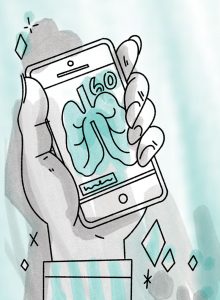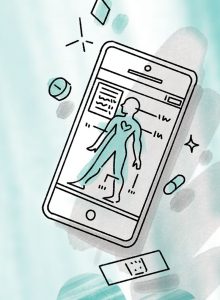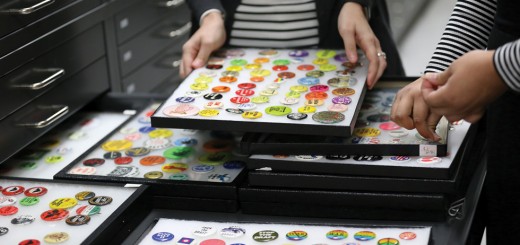Is Mobile Health Good for You?
SJSU experts debate mHealth’s ability to make healthcare more accessible and patient-centric.

Illustrations: Michelle Lagasca
Counting steps, burning calories, measuring water intake, analyzing sleep cycles—these days it seems that everyone is monitoring some aspect of their health with a fitness band or smartwatch. These wearable devices may be among the first things that spring to mind when one thinks about mobile health (mHealth), but they’re part of a much larger picture. According to the Food and Drug Administration, wearable devices and mHealth fall under the rubric of digital health, an area that also includes health information technology, telehealth, telemedicine and personalized medicine.
This diverse sector is ripe for innovation and entrepreneurs are responding, bringing new health apps and services to the market every day. Those active in the field agree that there is much to be gained with respect to patient focus and personalized service, but they also caution that there are still many questions around regulation, privacy and veracity of information to be addressed.
Greater Patient Engagement
“A lot of people have been jumping on the mobile health bandwagon with all manner of wellness apps, because it’s a relatively easy pathway to market,” observes Guna Selvaduray, chair of SJSU’s Department of Biomedical, Chemical and Materials Engineering. “These types of apps aren’t subject to the same level of FDA scrutiny as many other medical devices, so the barrier to entry is much lower. But there’s a big difference between wellness and health.” There’s nothing wrong with improving wellness, Selvaduray continues, but we also need to be realistic about the utility of the data we’re collecting. “Having the ability to take one’s blood pressure four or five times a day and forward it to your physician doesn’t automatically mean that your health will improve,” he points out. “It’s valuable data, of course, but it needs to be placed in a larger context. If you discover your blood pressure is too high over an extended period of time, for example, you’re going to need guidance on how to address the problem. mHealth definitely has a role to play in improving healthcare and outcomes, but it should not be viewed as a panacea.”
“mHealth definitely has a role to play in improving healthcare and outcomes, but it should not be viewed as a panacea.” —Guna Selvaduray
That said, Selvaduray says there are many exciting mobile initiatives underway. He cites Proteus Digital Health, Inc.—a Redwood City, California, business offering a new category of therapy—as a prime example of a company that’s making healthcare more patient-centric through technology. Proteus Discover, the company’s flagship offering, provides physicians a way to monitor patient adherence and response to prescribed medications. “Patients don’t always take their prescriptions regularly or in the manner prescribed—behaviors that can negatively affect health outcomes,” says Selvaduray. “The technology Proteus has created is addressing that problem in a meaningful way.”
When patients use Proteus Discover, they take a prescribed medication co-encapsulated with an ingestible sensor (by their pharmacist), which transmits information to a wearable patch, explains Proteus VP of Product Integration and Security Todd Thompson, ’89 Mechanical Engineering. The patch then creates a digital record that is sent to the patient’s mobile device and to the Proteus Portal, where doctors and caregivers can access the information shared by the patient. This technology is particularly beneficial to those with cardiovascular and infectious diseases, where high medication adherence is not only critical to improving patient outcomes but also helpful in reducing the healthcare costs due to excess hospitalizations, emergency room visits and office visits. “For example, non-adherence to medication is one of the most likely causes of re-admission for patients with heart failure,” says Thompson.
Digital health tools like Proteus Discover also improve patient engagement because they make the consequences of patients’ actions clearer to them, says Thompson. “We’ve found that once patients start to understand the cause and effect of their medication-taking behaviors, they become more engaged in their own healthcare. They gain confidence in their ability to manage their disease and have some concrete data they can discuss with their physicians, which makes for a richer dialogue between patient and provider, and ultimately improves outcomes.” Digital healthcare is all about patients first, Thompson asserts, and tools like Proteus Discover provide information that not only empowers patients but also enables physicians to deliver more focused care.

Illustrations: Michelle Lagasca
Increased Access to Information
While the benefits of a digital health product like Proteus are clear, one wonders if there are other ways in which mobile offerings can make healthcare more accessible and patient-centric. “Yes, unequivocally,” asserts Bryan Dang, ’16 Nursing. A nurse with a minor in human systems integration, Dang says mobile technology can also be a boon to healthcare education. With the rapid developments in cloud computing, artificial intelligence and virtual reality, individuals increasingly view technology as part of the fabric of life, he explains. Dang points to a 2017 Pew Research Center survey that indicates that 95 percent of Americans own a cellphone of some kind and 77 percent own a smartphone, a dramatic increase from the 35 percent recorded in 2011. It’s only natural that technology would find its way into healthcare, he asserts. “The novelty of tech is fading—it’s more commonplace—so when it comes to healthcare these days, people are more focused on privacy issues and the veracity of the information they’re receiving than the way that information is accessed.”
Dang is working to expand that access through Syminar, a company he co-founded to deliver healthcare education through virtual reality. He came up with the idea after leaving his job at Google to study human systems integration and complete nursing school. “Hands-on training for healthcare workers is critical,” he explains, “but to mitigate the risk of injury, clinicians train with sophisticated, high-tech mannequins in simulation centers before working on actual patients. These centers are very expensive to equip, which can make medical education costlier and more difficult to access.” Dang’s solution: an online classroom that enables teachers and remote students a more efficient means of interacting through virtual reality. By transposing the physical learning space into a lean, virtual reality environment, teachers can deploy a range of classroom capabilities—from demonstrating procedures to distributing learning materials, answering questions and giving quizzes—to an unprecedented number of online students. The potential applications are myriad. “Syminar could be used in a triage center—allowing people to respond remotely to a natural disaster, for example—or to educate health providers in remote rural settings who might not have access to a simulation center. It’s really about using telecommunications to bring an increasingly divergent mobile audience closer together.”

Illustrations: Michelle Lagasca
Enhanced Personalization of Services
Using telecommunications in the service of healthcare is also what drives Theresa Pittman, ’78 Nursing Science, ’94 MS Nursing Education. Pittman is chief clinical officer at Opionato, a service that provides personalized, evidence-based fertility advice to couples during their fertility journeys through phone and email consultations. She joined the startup after working as a fertility nurse practitioner for 30 years. “Fertility journeys are lengthy, stressful and expensive,” says Pittman, “and over the course of my career, I’ve witnessed many success stories as well as many failures. I was seeking a way to use my decades of experience to reach more individuals, in different locations and at various points in their fertility journey. Opionato allows me to do both.”
Pittman is passionate about her work and grateful that she can employ a technology-driven health solution to empower individuals as they make their way through the fertility process. “When I worked in the traditional medical setting, I could see that patients didn’t always understand what they were being told. Now I can answer their questions in the privacy and comfort of their own home, no matter what stage of the fertility journey they’re in. It’s immediate, convenient and highly individualized.” She is quick to add, however, that mHealth initiatives complement, rather than replace, traditional care. “Technology simply allows us to become more client-focused and offer more cost-effective options.”
In Christine Hagar’s experience, technology can sometimes provide the only viable healthcare option. An associate professor in SJSU’s School of Information, Hagar is an active member of Mobile HIFA (mHIFA), a sub-group of Healthcare Information for All (HIFA), that is working to make sure that first aid, maternal, child health and nutrition information are available for citizens in low- and middle-income countries via mobile phone, free of charge. Mobile phone availability continues to grow around the globe, notes Hagar, while healthcare providers are often scarce, making the need to make healthcare information available via mobile devices even more pressing.
“Thousands of children and adults in low-income countries die from lack of appropriate life-saving treatment, a situation that could be mitigated by mobile phones equipped with free health information.” Ideally, says Hagar, the information would be pre-loaded onto the handsets prior to sale and would not require a connection to access. The information would cover topics such as common childhood illnesses, complications of pregnancy and childbirth, first aid and nutritional information. “Individuals in low- or middle-income countries frequently lack access to any kind of healthcare or professional advice, and they are forced to make healthcare decisions—which are often wrong and dangerous—without access to reliable guidance.” For example, Hagar says, children suffering from diarrhea need lots of fluid, but many parents wrongly believe they should withhold fluids. “Four in 10 children in India receive less to drink when they have diarrhea, which tragically increases their risk of death,” she explains. A basic mHealth initiative that equipped every mobile phone with basic healthcare information could combat such problems. “With a mobile application, the information is immediately available at the point of need, which is key.”
“Thousands of children and adults in low-income countries die from lack of appropriate life-saving treatment, a situation that could be mitigated by mobile phones equipped with free health information.” —Christine Hagar
Being available at the point of need is Winifred (Wynn) Schultz-Krohn’s modus operandi. Eighteen years ago, the SJSU professor of occupational therapy (OT) founded a program that offers OT services to residents at Family Supportive Housing, a local shelter that provides temporary housing to support families experiencing homelessness. For this healthcare professional, mHealth is quite literally mobile: she and a handful of student volunteers drive to the shelter to provide occupational therapy services to help the families. “Instead of forcing the residents to find OT services and then figure out a way to reach a provider, we bring services to them.”
Occupational therapy helps people with things they do in day-to-day life, Schultz-Krohn explains, making it a valuable healthcare offering for individuals trying to get back on their feet. During the school year, Schultz-Krohn and her students are at the shelter one to two days a week, and in the summer, students are at the shelter full-time, completing their clinical experience under Schultz-Krohn’s supervision. They’re running camps for school-age children as well as teaching imaginative play to preschoolers, financial literacy to teens, and work readiness training to parents. “The program has evolved since I founded it 18 years ago,” says Schultz-Krohn. “I’m always listening, asking about needs and altering programs accordingly.”
While it remains to be seen what long-term impact mHealth and other digital health offerings will have on healthcare and health outcomes, one thing is clear: this trend will continue to grow. “We’re seeing a democratization of access to personalized and evidence-based health information and a friendlier approach to health through the use of technology,” asserts Pittman. Todd Thompson agrees. “In our experience, digital technology, including mHealth initiatives, makes healthcare more personal, more effective and more meaningful.”



